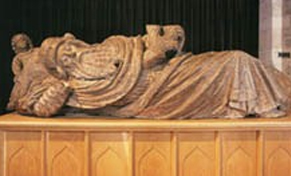A late 15th-century wood carving of Jesse, found at St Mary's Priory Church, Abergavenny. The one 'unarguably great' wooden figure to survive intact from the wreckage of the Reformation, it offers a subtle grafting of primitive pagan fertili
Only one unarguably great wooden figure survives intact from the wreckage of the British cultural revo-lution. It is the figure of a prophet which occupies one of the side chapels of St Mary's, a priory church in Abergavenny. This is the most impressive wood carving to have escaped the bonfires of the Reformation in Wales, and it is a work of stirring strangeness. A figure of Jesse, father of David and ancestor of Jesus Christ, it was carved out of the trunk of an oak tree sometime in the late 15th century.
In the theology of medieval Catholicism Jesse was thought of as the root from which Christ will grow. The severed stump that projects upwards from the Abergavenny Jesse's groin was once a tree of other carvings - other figures and tales - twisting and growing up the wall to reach its climax in a carving of Christ's life, death and Resurrection. The Tree of Jesse was one of the commonest of late medieval symbols, an image which linked the prophecies of the Old Testament to their fulfilment in the New Testament, and which also poetically figured one of the central metaphors of the Christian story by envisaging Christ's Resurrection as a divine version of the diurnal miracle by which green shoots sprout, every spring, from the bare trees of winter.
The Abergavenny Jesse is an image with roots that clutch. The tree was an ancient focus of fertility cults stretching from Athens to Snowdonia, and the Christian Tree of Jesse was an attempt to appropriate one of the oldest and...


